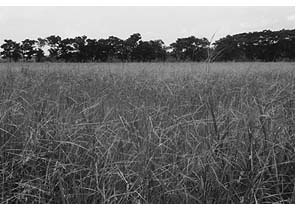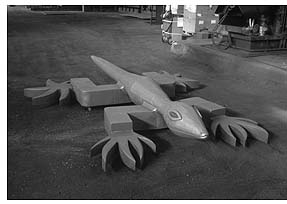 Mitsuaki Tanabe's new work, Wild Rice - In Situ Conservation of MOMI 2000, advocates the conservation of wild rice and its natural habitat located in tropical and semi-tropical regions of Asia. Wild rice is originally a water plant, which maintains its life in wetlands and shallow bodies of water with generational changes that take place over an estimated period of ten thousand years. This habitat is rapidly being lost by environmental destruction caused by overdevelopment, and the ancestral varieties of rice seeds, an important genetic resource, are at risk of extinction in the near future. Mitsuaki Tanabe's new work, Wild Rice - In Situ Conservation of MOMI 2000, advocates the conservation of wild rice and its natural habitat located in tropical and semi-tropical regions of Asia. Wild rice is originally a water plant, which maintains its life in wetlands and shallow bodies of water with generational changes that take place over an estimated period of ten thousand years. This habitat is rapidly being lost by environmental destruction caused by overdevelopment, and the ancestral varieties of rice seeds, an important genetic resource, are at risk of extinction in the near future.
 This is a critical situation not only for agricultural specialists but also for many other people in a broad range of fields who are aware of the importance of rice in preserving both food resources and culture. As an artist, Tanabe is extremely concerned about this situation and he has joined with scientists who feel the same way to make a strong appeal for conservation and education through his work. This is a critical situation not only for agricultural specialists but also for many other people in a broad range of fields who are aware of the importance of rice in preserving both food resources and culture. As an artist, Tanabe is extremely concerned about this situation and he has joined with scientists who feel the same way to make a strong appeal for conservation and education through his work.
  The new sculpture will be donated to the Indian Council of Agricultural Research, an institution that maintains a large area of wild rice habitat in Bhubaneswar and is working hard to develop sound policies for preserving it. It will be placed outside the National Central Rice Research Institute in ORISSA in eastern India. The artist has made this monument and is donating it of his own free will. The new sculpture will be donated to the Indian Council of Agricultural Research, an institution that maintains a large area of wild rice habitat in Bhubaneswar and is working hard to develop sound policies for preserving it. It will be placed outside the National Central Rice Research Institute in ORISSA in eastern India. The artist has made this monument and is donating it of his own free will.
 In 1997, Tanabe donated a similar outdoor sculpture on the same theme to the Thai Department of Agriculture. It commemorated the beginning of a wild rice habitat conservation project sponsored by the royal house of Thailand. It is a huge stainless steel representation of a momi, a rice seed in the husk, measuring 33 meters in length and weighing 4.5 tons. The wild rice seed has whiskers that extend out length ten times the length of the grain itself, and the sculpture takes the same form. This monument is located on a water-way that supplies water to the extensive experimental paddies at the Rice Research Institute at Patham Thani on the outskirts of Bangkok. In 1997, Tanabe donated a similar outdoor sculpture on the same theme to the Thai Department of Agriculture. It commemorated the beginning of a wild rice habitat conservation project sponsored by the royal house of Thailand. It is a huge stainless steel representation of a momi, a rice seed in the husk, measuring 33 meters in length and weighing 4.5 tons. The wild rice seed has whiskers that extend out length ten times the length of the grain itself, and the sculpture takes the same form. This monument is located on a water-way that supplies water to the extensive experimental paddies at the Rice Research Institute at Patham Thani on the outskirts of Bangkok.
 The new work is a sprouting grain of rice, a motif that Tanabe has used in two previous works. These are permanently installed in the observation hall of the International Rice Research Institute in Manila and the museum of the National Rice Research Institute on the outskirts of Bangkok. The former is a colored wood sculpture made of red lauan and the latter a light, playful work woven with strips of local bamboo. The new work is a sprouting grain of rice, a motif that Tanabe has used in two previous works. These are permanently installed in the observation hall of the International Rice Research Institute in Manila and the museum of the National Rice Research Institute on the outskirts of Bangkok. The former is a colored wood sculpture made of red lauan and the latter a light, playful work woven with strips of local bamboo.
 The momi is a seed and therefore contains elements of both life and death. A decision is made in favor of life when the seed sprouts. As shown in Tanabe's sculpture, a thick root reaches out boldly and inserts itself into Mother Earth, joining the seed to the earth like an umbilical cord, and the fresh bud pokes up toward the sky like a little boy's penis, seeking the light. At the moment of sprouting, death passes the generational baton to life and retreats solemnly to the underworld, and life sets out energetically on a journey toward future abundances. Tanabe has inscribed the execution date of this work, 2000, into its steel surface, injecting it with the emotions of a witness to the turn of the century. The momi is a seed and therefore contains elements of both life and death. A decision is made in favor of life when the seed sprouts. As shown in Tanabe's sculpture, a thick root reaches out boldly and inserts itself into Mother Earth, joining the seed to the earth like an umbilical cord, and the fresh bud pokes up toward the sky like a little boy's penis, seeking the light. At the moment of sprouting, death passes the generational baton to life and retreats solemnly to the underworld, and life sets out energetically on a journey toward future abundances. Tanabe has inscribed the execution date of this work, 2000, into its steel surface, injecting it with the emotions of a witness to the turn of the century.
 Through his work, Tanabe often conveys the results of the most up-to-date scientific research to future generations. For example, this sprouting rice grain is made with the latest stainless steel casting techniques and the highest grade of steel available today. In order to give life to the momi through this extremely hard and non-organic material, Tanabe has experimented boldly with his own original ideas. Through his work, Tanabe often conveys the results of the most up-to-date scientific research to future generations. For example, this sprouting rice grain is made with the latest stainless steel casting techniques and the highest grade of steel available today. In order to give life to the momi through this extremely hard and non-organic material, Tanabe has experimented boldly with his own original ideas.
 Tanabe has converted a method of gouging that is ordinarily used in a limited way to remove burrs from cast metal and uses it to dig deep into the material over its entire surface. In this technique, known as arc air gouging, the steel is melted with a high temperature electrical arc and the molten steel is blown away with high-pressure air. Tanabe employs this process manually, attacking the surface of the hardest material made today with what appears to be artificial lightning. The factory where he does the work is like a scene from hell, with explosive noises, flashing lights, and white-hot sparks flying about. Afterward he carefully polishes each of the innumerable craters dug into the surface to produce the finished MOMI sculpture. This process recalls the unending toil required to grow rice. Tanabe has converted a method of gouging that is ordinarily used in a limited way to remove burrs from cast metal and uses it to dig deep into the material over its entire surface. In this technique, known as arc air gouging, the steel is melted with a high temperature electrical arc and the molten steel is blown away with high-pressure air. Tanabe employs this process manually, attacking the surface of the hardest material made today with what appears to be artificial lightning. The factory where he does the work is like a scene from hell, with explosive noises, flashing lights, and white-hot sparks flying about. Afterward he carefully polishes each of the innumerable craters dug into the surface to produce the finished MOMI sculpture. This process recalls the unending toil required to grow rice.
  The Indian poet Tagore wrote that the true angel is a farmer who takes off his robes and sweats in the field. This sacred labor has nourished a common culture among the peoples of Asia, whose main source of food is rice, and made it possible for rice to be cultivated from the tropics to the subarctic all over the world. As a result, rice will be an extremely important food resource in the twenty-first century as world population continues to grow. Wild rice has been an essential element in maintaining the development of human life and culture and it still has great adaptability and potential for supporting life. Tanabe uses sculpture to express his fervent hope that the compressed energy and beauty of the momi will never be destroyed. The Indian poet Tagore wrote that the true angel is a farmer who takes off his robes and sweats in the field. This sacred labor has nourished a common culture among the peoples of Asia, whose main source of food is rice, and made it possible for rice to be cultivated from the tropics to the subarctic all over the world. As a result, rice will be an extremely important food resource in the twenty-first century as world population continues to grow. Wild rice has been an essential element in maintaining the development of human life and culture and it still has great adaptability and potential for supporting life. Tanabe uses sculpture to express his fervent hope that the compressed energy and beauty of the momi will never be destroyed.
 As a companion to this new work, Tanabe is simultaneously creating a large figure of a lizard that he saw with his own eyes in a field of wild rice, using stainless steel forging, an unusual technique for sculpture. Rice habitat preservation helps preserve the diversity of all forms of life. This lizard image habitat, which also advocates habitat conservation, will be installed on the Gonohe Plateau in Aomori prefecture as a witness the coming of rice cultivation to a cold region of a remote island in the Far East. As a companion to this new work, Tanabe is simultaneously creating a large figure of a lizard that he saw with his own eyes in a field of wild rice, using stainless steel forging, an unusual technique for sculpture. Rice habitat preservation helps preserve the diversity of all forms of life. This lizard image habitat, which also advocates habitat conservation, will be installed on the Gonohe Plateau in Aomori prefecture as a witness the coming of rice cultivation to a cold region of a remote island in the Far East.
|

 Å@
Å@



 Å@
Å@

